Opportunity in the shifting sands of Mideast machinery market
With the region mulling high-speed transport options, machinery companies and dealers stand to gain from supplying the technology and maintenance that will go into keeping the projects running, says Patrick Ditcham, head of machinery and business assets at Cavendish Maxwell

There has been a lot of recent interest in hyperloops from the press and on social media. First, there was the announcement in November last year that the Dubai government had signed a deal with a US firm to explore the possibility of building a hyperloop transport system. The system would be built between Dubai and Abu Dhabi, cutting travel time between the two cities to 12 minutes.
Secondly, there was the news in July this year that tech entrepreneur Elon Musk had received verbal approval from the US government to build a hyperloop tunnel from Washington, DC to New York, claiming that passengers would be whisked along in a magnetically levitated pod in just 29 minutes.
A few decades ago this would have been met by laughter and ridicule. However, with the success of large projects such as the world’s largest particle accelerator, the Hadron Collider, and the fact that the average smart watch today has more computer power than any of the Apollo spacecraft that first put man into space and on the moon, people are a lot more accepting of technological advancements.
People in this region may be interested to know that high-speed travel between the major cities of the GCC is nothing new. In fact, as early as 1908 the first narrow gauge railway, the Hejaz railway, was opened in Saudi Arabia and ran from the Jordan border to Medina. But this was subsequently closed in 1920 after experiencing damage from World War I. Since then, several cargo projects have been completed and the first commercial passenger service was opened between Dammam and Riyadh in 1981. This line is now in the process of being upgraded to a high-speed line, allowing speeds in excess of 200kmph to be achieved.
In the UAE, other than the Dubai Metro and tram systems, there is an operational railway in Abu Dhabi running between Shah and Habshan to Ruwais, the port on the Saudi border. There are also plans to extend this network to Abu Dhabi City and eventually to the Northern Emirates. Although in many parts of the world rail travel has been a mainstay of transportation for many years, progress in this part of the world has been slow because of a seemingly innocuous substance which is synonymous with this part of the world – sand.
Trying to build a rail line through the desert has its own challenges, such as the variation in terrain and the extreme heat. These have mostly been overcome, but the constant shifting sand is proving to be a big problem. So far, no one has come up with a failsafe solution, which has raised significant concerns about safety and maintenance issues.
These problems should come as music to the ears of rail maintenance contractors. In order to keep the lines open, enormous maintenance efforts are required, meaning large deployments of machinery. The never-ending threat of train derailment caused by sand covering the tracks, moving intruder dunes shifting over tracks and parked trains getting trapped mean continual work is required to keep the tracks clear.
In addition, the entire system’s serviceability can be affected by ballast contamination, asymmetric rail grinding and dust being lifted by running trains. And of course, all this maintenance work requires specialist plant and machinery.
The good news for maintenance firms is that all this specialised machinery also needs to be regularly serviced and repaired, which should provide more work to the local area. This is a good opportunity for construction machinery dealers to introduce more advanced equipment and machinery into the GCC.
So, what of the proposed hyperloop system? It is some years off, as the technology of propelling a magnetically levitated pod within a near-total vacuum is still only in the testing phase, although engineers in the US reached speeds of over 320kph in July with self-driving cars.
Then there are the same problems that exist already in the Middle East – sand, and whether to tunnel below the dunes or construct a tube tunnel above ground, which could well face similar problems with shifting dunes.
Leaving all the construction problems aside, it is very exciting to think that in the not too distant future we could be travelling between major cities throughout the region and in other countries in a matter of mere minutes!

























